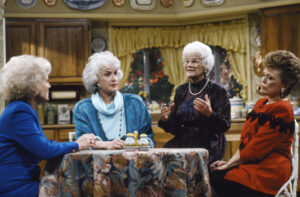
The iconic sitcom “The Golden Girls” captivated audiences for seven seasons with its witty humor, heartwarming moments, and the undeniable chemistry between its four leading ladies – Bea Arthur, Betty White, Rue McClanahan, and Estelle Getty. However, behind the scenes, the relationship between two of the show’s stars, Bea Arthur and Betty White, was far more complex than their on-screen personas suggested.
For years, rumors had swirled about tensions and animosity between the two actresses, with reports of constant bickering and clashes on the set. It was widely believed that the two women simply didn’t get along, and that their characters’ friendly rapport masked a real-life rivalry.

But in the years since the show’s finale in 1992, a more nuanced and surprising picture has emerged about the nature of Bea Arthur and Betty White’s relationship.
“There was certainly an element of friendly rivalry between Bea and Betty,” explains TV historian and author Emily Nussbaum. “They were both incredibly talented comedic actresses, and there was a natural sense of competition there. But to say they outright disliked each other is an oversimplification of a much more complex dynamic.”
According to those close to the production, the two actresses had a relationship that was characterized by both affection and exasperation. They respected each other’s talents and abilities, but also clashed over creative differences and personal styles.
“Bea was the more reserved, serious-minded one, while Betty was the irrepressible, bubbly extrovert,” says former “Golden Girls” writer Stan Zimmerman. “There were times when their contrasting personalities would cause friction, but they also genuinely enjoyed each other’s company and had a real fondness for one another.”
This dynamic was particularly evident in the way the two women approached their craft. Bea Arthur, known for her deadpan delivery and subtle comic timing, often butted heads with Betty White’s more broad, physical style of humor. But rather than letting these differences divide them, they ultimately learned to embrace and play off of each other’s strengths.
“Bea and Betty pushed each other to be better, both on screen and off,” Nussbaum explains. “Their creative rivalry fueled the show’s success, even as it sometimes led to personal tensions. It was a complex relationship, but one built on mutual respect and admiration.”

In the years after “The Golden Girls” ended, Bea Arthur and Betty White remained friendly, occasionally reconnecting for events and interviews that allowed them to reflect on their time together on the iconic sitcom. And while the truth about their relationship may have been more nuanced than the popular perception, there’s no denying the indelible mark they left on television history – both individually and as a duo.
“Bea and Betty were icons, plain and simple,” says Zimmerman. “And their ability to capture the public’s imagination, even with all the behind-the-scenes drama, is a testament to their remarkable talents and the enduring power of ‘The Golden Girls.'”
